- 건강 상태 인식과 관련 행동: 흡연, 음주, 스트레스, 운동, 숙면 - WIN 다국가 조사
- 조사일 : 2020/12/15
- [GallupReport(20210421)_Health_WIN.pdf] 다운로드
● 2021년 4월 21일(수) 공개 | 문의: 02-3702-2571/2621/2622
건강 상태 인식과 관련 행동 - WIN 다국가 조사
→ 한국+세계 조사 결과 파일 다운로드(PDF)
/ 세계 조사 개요
2020년 10~12월 34개국 성인 총 29,252명 전화/온라인/면접조사(주제별 참여국 상이)
/ 한국 조사 개요
- 조사기간: 2020년 11월 5~29일
- 표본추출: 2단계 층화 집락 무작위 추출
- 응답방식: 면접조사원 인터뷰
- 조사대상: 전국(제주 제외) 만 19세 이상 1,500명
- 표본오차: ±2.5%포인트(95% 신뢰수준)
- 응답률: 26%(총 접촉 5,856명 중 1,500명 응답 완료)
- 의뢰처: 한국갤럽-WIN 자체 조사
/ 조사 항목
- 본인의 전반적인 건강 상태 인식(4점 척도)
- 건강 관련 행동 빈도(5점 척도): 흡연, 음주, 스트레스, 운동, 숙면
(※ 세계 조사 상세 결과는 첨부 파일 참조)
요약
- 2020년 10~12월 34개국 성인 중 79%, 스스로 건강하다고 인식
- 코로나19 이전과 크게 달라지지 않아
- '항상+자주 한다': 숙면 64%, 운동 39%, 스트레스 경험 31%, 흡연 17%, 음주 15%
- 한국인은 음주 잦고 운동 덜하는 편, 2019년 대비 2020년 숙면자 감소
- 코로나19 이전 대비 스트레스·운동 빈도, 한국 남녀 변화 경향 달라
조사 결과
2020년 10~12월 34개국 성인 중 79%, 스스로 건강하다고 인식
- 코로나19 이전과 크게 달라지지 않아
글로벌 조사 네트워크 WIN이 2020년 10~12월 34개국 성인 29,252명에게 본인의 전반적인 건강 상태가 어떠하다고 생각하는지 물었다(4점 척도). 그 결과 20%가 '매우 건강하다', 59%는 '건강한 편'이라고 답했다. 즉, 34개국 성인 열 명 중 여덟 명(79%)이 전반적으로 건강하다고 생각한다. 17%는 '건강하지 않은 편', 3%는 '전혀 건강하지 않다'고 답했고 1%는 의견을 유보했다.
◎ 지난 2018년과 2019년에도 조사에 참여한 약 40개국 성인 중 76%, 77%가 스스로 건강하다고 답한 바 있다. 코로나19 팬데믹으로 많은 사람이 목숨을 잃거나 감염 후유증을 앓게 되었고, 일부 국가는 여전히 기약 없는 백신 접종을 기다리는 상태지만 자신의 건강 상태에 대한 인식은 이전과 크게 달라지지 않았다. 이는 개개인이 건강을 신체적 상태 외 다른 측면까지 포함해 생각하기 시작했음을 보여준다. 코로나19라는 실체적 위협에 직면한 상황에서 감염을 피했거나 살아남은 것만으로도 건강하다고 생각할 수 있으며, 방역을 위해 일상 위생에 신경 쓰는 등 스스로를 더 잘 돌보게 된 결과일 수도 있다.
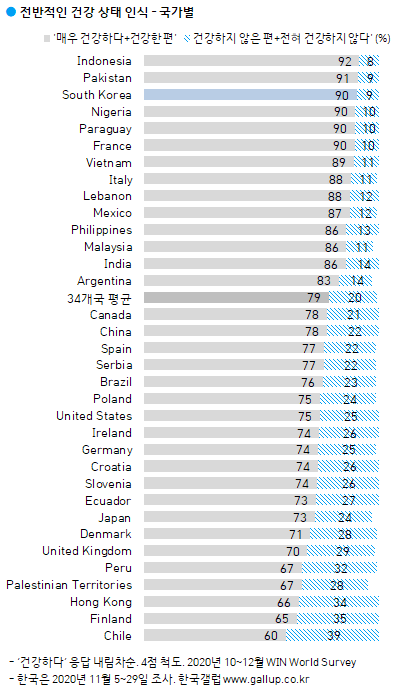
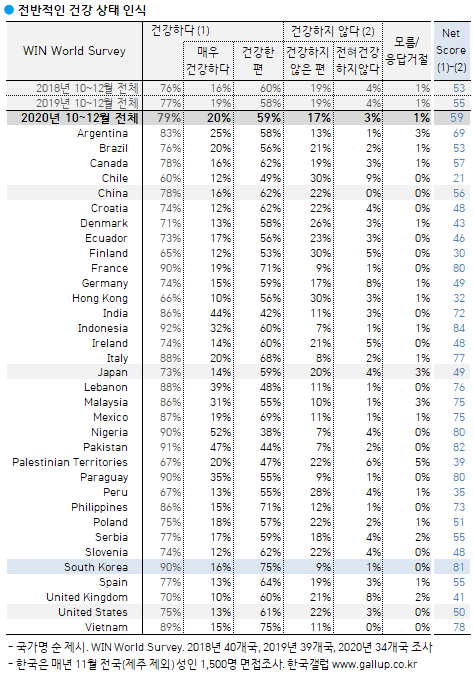
한국, '나는 전반적으로 건강하다' 90%로 34개국 중 최상위권
- '매우 건강하다' 1994년·2002년 40% 안팎 → 2018년 이후 10%대
- 코로나19 전후 비교하면 20·30대 남성, 20~40대 여성 '매우 건강하다' 응답 감소 두드러져
한국 조사는2020년 11월 5~29일 전국(제주 제외) 성인 1,500명을 대상으로 했다. '전반적으로 매우 건강하다'가 16%, '건강한 편' 75%, '건강하지 않은 편' 9%, '전혀 건강하지 않다' 1%다. '매우 건강하거나 건강한 편' 응답은 90%로, 34개국 중에서도 최상위권에 속한다. 1994년, 2002년 같은 질문을 했을 때 '매우 건강하거나 건강한 편' 응답은 각각 75%, 82%였다.
'매우 건강하다'는 응답만 보면 1994년(36%)과 2002년(43%) 40% 안팎에서 2018년 이후 10%대로 크게 감소했다. 코로나19 전후인 2019년과 2020년을 비교하면 20·30대 남성과 20~40대 여성에서만 '매우 건강하다'는 응답이 10%포인트 가까이 감소했고, 그 외 성·연령대에서는 거의 변함없다는 점에 주목할 만하다.
◎ '매우 건강하다'는 응답은 고연령일수록 적고(20대 30%; 60대+ 7%), 한국뿐 아니라 다른 나라에서도 마찬가지 경향을 보인다. 우리나라는 21세기 들어 급격한 고령화가 진행되고 있으므로, 전반적인 건강 상태 인식 저하는 불가피한 현상일 수도 있다. 그러나, 과거와 비교하면 고령층뿐 아니라 젊은 층에서도 '매우 건강하다'는 응답이 현저히 줄었다. 2002년 조사에서는 당시 20대의 54%, 30·40대는 약 45%, 50대 이상에서도 30%가 '매우 건강하다'고 답했다.
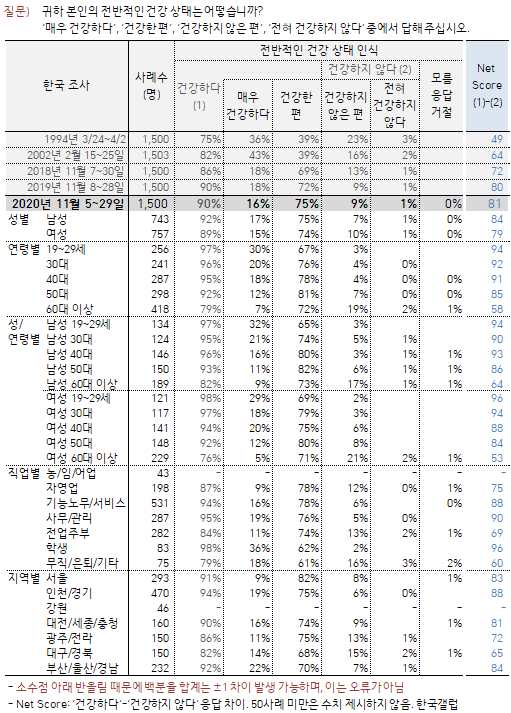
___
2020년 34개국 성인의 건강 관련 행동 '항상+자주 한다':
숙면 64%, 운동 39%, 스트레스 경험 31%, 흡연 17%, 음주 15%
- 한국: 음주 잦고 운동은 덜하는 편, 2019년 대비 숙면자 감소
다음으로, 건강에 좋은 행동 두 가지(숙면/잘 잠, 운동)와 건강에 좋지 않은 행동 세 가지(흡연, 음주, 스트레스) 각각에 대한 빈도를 물었다. 그 결과 34개국 성인 중 64%가 '평소 잠을 잘 잔다'(이하 5점 척도 중 '(항상+자주) 한다' 응답 기준), 39%는 규칙적으로 운동한다고 답했다. 31%는 일상에서 스트레스에 시달리고, 흡연과 음주가 잦은 사람은 각각 17%, 15%로 파악됐다.
◎ 한국인 중에서는 59%가 잠을 잘 자는 편이고, 28%가 규칙적으로 운동한다. 스트레스가 잦은 사람은 27%, 음주와 흡연이 잦은 사람은 각각 25%, 19%로 나타났다. 한국의 음주자 비율은 34개국 평균을 웃돌고, 규칙적으로 운동하는 사람은 다른 나라보다 적은 편이라고 볼 수 있다. 34개국 중에서 한국보다 더 자주 술 마시는 나라는 일본(45%), 아일랜드(31%), 영국(30%), 덴마크(27%) 등이며, 캐나다(25%)와 미국·핀란드(23%)는 한국과 비슷한 수준이다.
◎ 코로나19 팬데믹 이전인 2019년과 비교하면, 2020년 한국인 중 흡연·음주·스트레스 경험·운동을 자주 하는 사람은 각각 1~3%포인트 늘었다. 단, 평소 숙면을 취하는 사람은 2019년 68%에서 2020년 59%로 감소한 점이 두드러진다.
응답자 특성별로 볼 때 흡연자와 음주자는 성·연령별 치우침 없이 고르게 늘었고, 숙면자 역시 고르게 줄었다. 그러나, 스트레스에 시달리는 사람은 남성(2019년 32% → 2020년 29%)에선 소폭 줄고 여성(20%→25%)에선 늘었다. 규칙적으로 운동하는 사람 역시 남성(24%→30%)에서는 증가, 여성(27%→25%)에서는 소폭 감소해 성별 차이를 보였다.
◎ 코로나19 이후 여행과 이동, 외식과 모임 등에 제약이 많아졌다. 직장인은 재택근무, 학생은 온라인수업 등으로 집안에 머무는 시간이 길어졌고, 무수한 볼거리를 제공하는 영상 서비스 이용이 늘었다. 일부 업종 종사자는 소득이 줄어 어려움을 겪고 있다. 이러한 일상의 변화는 한국인이 예전보다 흡연·음주를 더 자주 하고, 편히 잠들지 못하는 것과 무관치 않아 보인다.
참고로, 만 13세 이상 한국인의 최근 한 달 OTT 유료 서비스 이용률은 2020년 초 10%에서 2021년 초 23%로 늘었다. 유튜브(무료 포함) 최근 한 달 이용률은 80%를 웃돈다(60대 이상 2020년 40% → 2021년 57%). 2021년 3월 한국갤럽의 만 25~54세 직장인 조사에 따르면 코로나19 이후 회식 빈도 감소 76%, 소득 감소 48%, 회사 경영 상황 악화 52%, 업무 스트레스 증가 52%, 가족과 함께하는 시간 증가 48% 등으로 나타난 바 있다(→ G20210329).
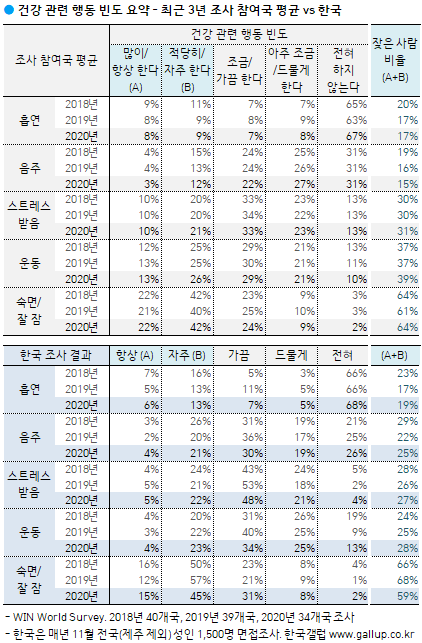
__
국가별 & 한국 교차 집계표
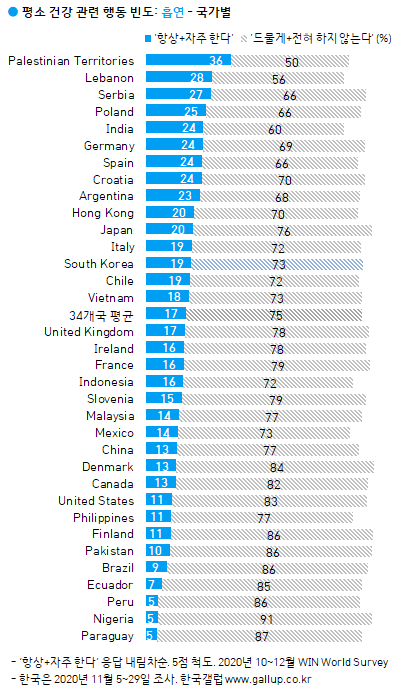
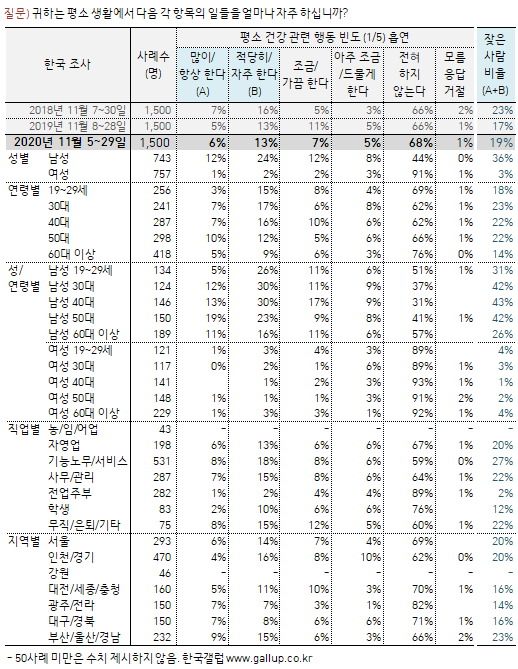
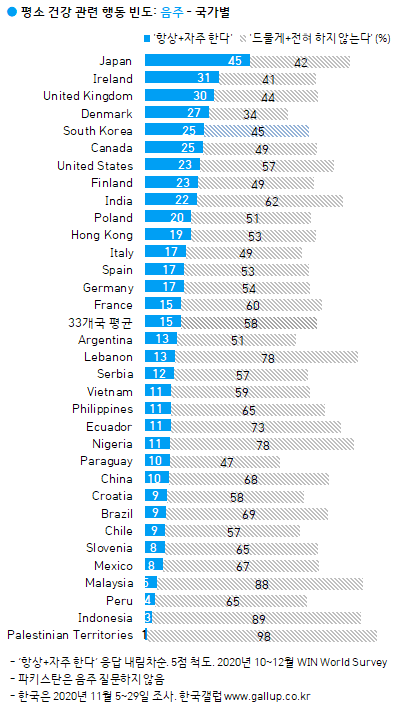
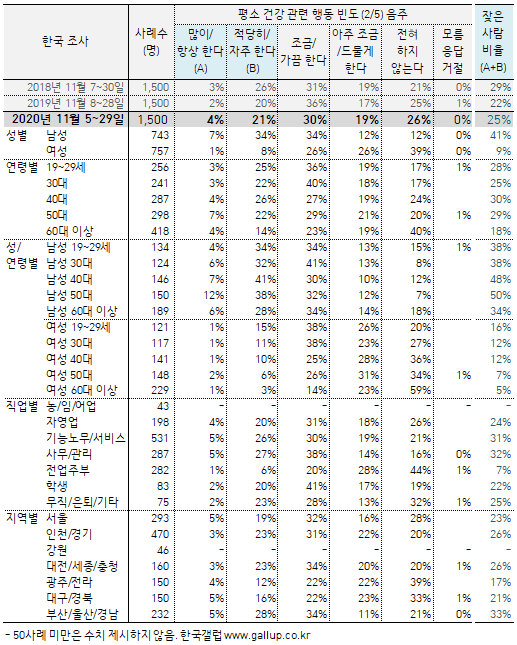
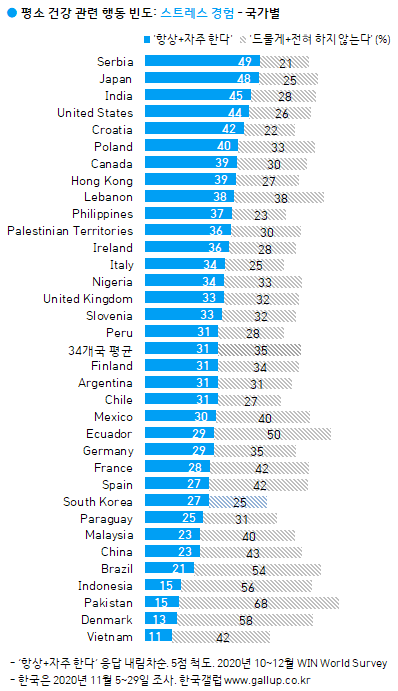
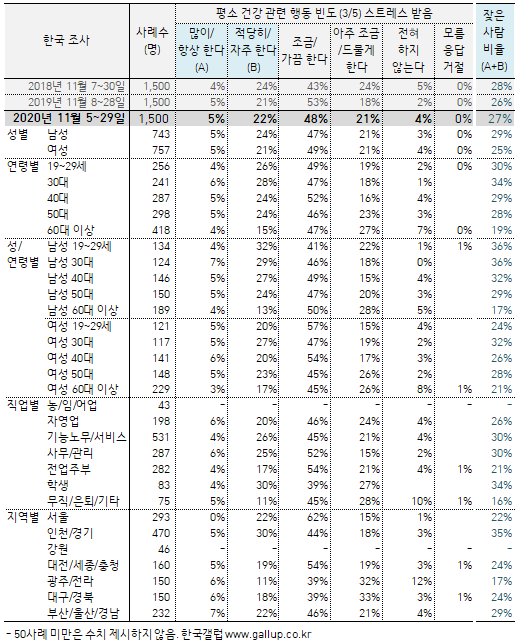
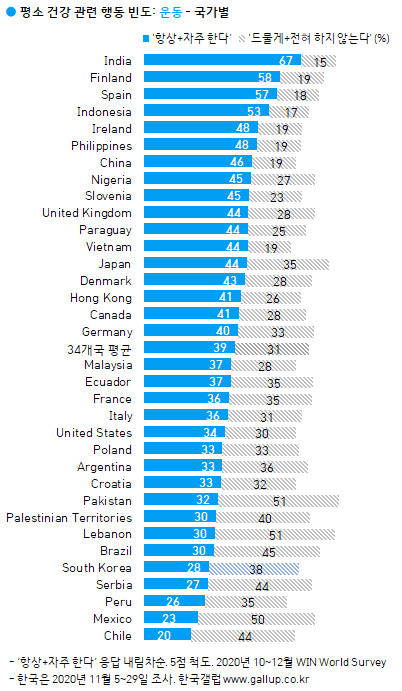
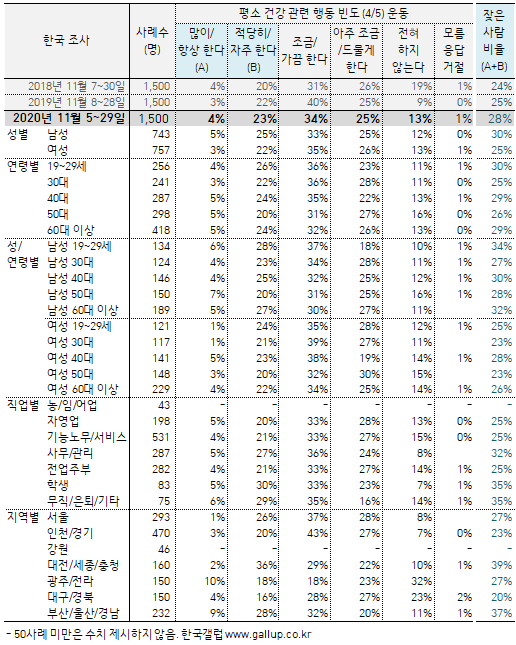
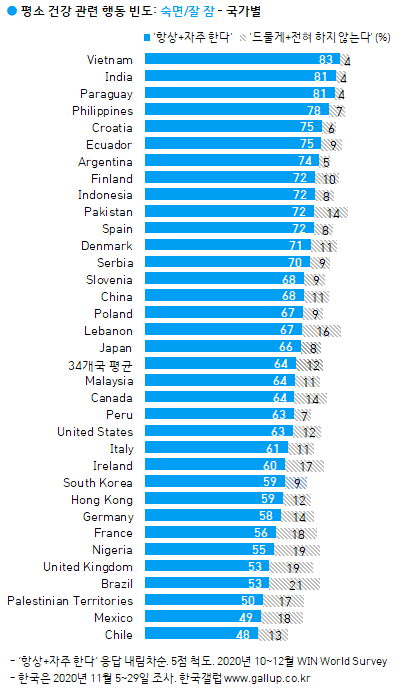
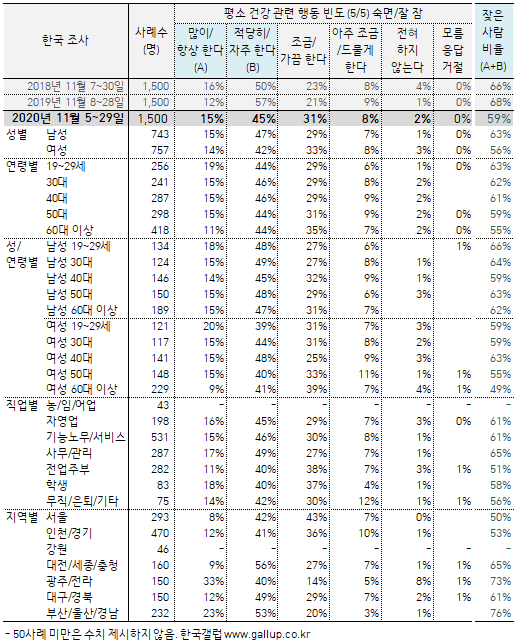
──────────────────────
Health Perception and Lifestyle in Global Pandemic Times
──────────────────────
WIN International, the world's leading association in market research and polling, has published the Annual WIN World Survey (WWS - 2020) exploring the views and beliefs of 29,252 individuals among citizens from 34 countries across the globe about their health and lifestyle. The survey analyzes views and opinions related to the perception of health and habits of citizens.
HEADLINES
The year 2020 was full of unexpected changes, marked mainly by COVID-19 pandemic. Global economic and health crisis, alongside the adjustment of people to new lifestyles, were central last year.
In this context, WIN analyzed individuals’ health perception. While health per se used to be considered primarily as a biological and physical condition, nowadays other variables are considered as much important, such as the context we live in, our culture, our values, as well as the mental, cognitive and psychological conditions.
Despite all the negative consequences caused by the pandemic during the year 2020, 79% of the global population perceived themselves as healthy1. The consistent result with previous measurements reveals that individuals worldwide might have started thinking about health as a set of different aspects besides the physical state. Of course, COVID19 is a very real and tangible threat, but for this very reason, people might consider themselves healthy even just because they could survive or avoid COVID19. In addition, precisely because of the threat caused by the pandemic, people might have started taking better care of themselves with simple, everyday actions.
However, despite the large majority considers themselves healthy, 20% of the population still consider themselves not healthy2. Results shows that males tend to perceive themselves healthier than females. On the other hand, the survey reveals that the highest the education level of individuals, the healthiest they perceive themselves: some could argue that maintaining certain levels of activity by having an employment, studying and/or being a housewife seems to impact positively on the health perception compared to people being unemployed or retired.
While keeping in mind the broader meaning of health, citizens in Africa consider themselves among the healthiest continent (90%)1. On the global picture, Africa was far less hit by the pandemic in 2020 compared to other continents like Europe and Americas. On the other hand, MENA is the region with the lowest rate of health perception observed (72%). When looking at countries, citizens in Indonesia (92%), South Korea (91%) and Pakistan (91%) consider themselves healthier than citizens in Hong Kong (66%), Finland (65%) and Chile (61%), which are on the bottom of the ranking.
As previously mentioned, health perception involves a complex mixture of variables, including everyday habits. In the present study, we focused on five specific habits which were both categorized as good and bad habits, and as action based and non-action based- habits. The difference is that the latter relies on variables not always subjected by people´s choice. The positive habits explored in the study were “sleep well” (a non-action based habit) and “exercise” (an action-based habit).
Sleep well
Sleeping well is necessary for the good maintenance of both the body and the cognitive functioning, as well as emotional regulation. During 2020, 64%3 of the global population admits to sleep well, an even better rate compared to last year´s (+3).
Males tend to sleep well more frequently than females, whereas people aged 35 to 45, probably because they’re more involved in their work lives than other age groups, tend to sleep well less often. Additionally, the highest the social class of belonging, the better they sleep; a similar tendency was observed in the relation between academic achievement and quality of sleep.
While retired people, full time workers and self-employed seems to have the better quality of sleep, housewives are the ones who sleep the worst, especially considering this specific context brought by the pandemic. Having children at home for months and being more often in charge of their activities (eating, studying, sleeping...) might have increased the stress within this category, unleashing a worst sleep quality.
APAC and Europe are the regions with the better sleep quality among their citizens (69%3 and 64%3, respectively), while the opposite occurs in MENA region (54%). Palestinian Territories (51%), Mexico (49%) and Chile (48%) are at the bottom of the ranking.
Exercise
According to the results, 39%3 of people worldwide exercised regularly during 2020, +2% than the two previous years. Nonetheless, there is still a high rate of people doing little or no exercises at all (31%). Despite the safety measures put in place, which prevented people from going to the gym or to field courts, people who already exercised before adapted to the new conditions and kept doing exercises. Probably, many others, considering the difficulties of walking and moving around, started exercising at home precisely due to the safety measures adopted.
Females exercise less than males and, once again, housewives are the ones who exercise the less among other employment categories. A positive outcome is that it’s not only the youngest (from 18 to 34) who exercise the most, but also people aged 65 or more, another possible consequence of COVID19 which is a higher threat for seniors.
In Africa, Europe and APAC 4 out of 10 people practice exercises regularly. Citizens in Finland (58%) and Spain (57%) are more likely to exercise than citizens in Peru (26%), Mexico (23%) and Chile (20%).
Suffer from stress
Suffer from stress is the first bad and non-action-based habit considered. During 2020, 31%3 of population suffered from stress regularly, while only 35% didn´t. Once again, despite the difficult context experienced, the variation between the results from 2020 and previous years is minimum.
Younger females (from 18 to 24), people with low incomes, students, unemployed, housewives and part-time workers are among the individuals who tend to suffer from stress the most. Unsurprisingly, these individuals also represent the most vulnerable population around the globe, a result that emphasizes the relation between social vulnerability and stress.
While MENA is the region with the highest rates of stress within the population (37%), the region with lesser stress rate is APAC (28%). In terms of countries, top countries with more stressed individuals are Japan (49%) and Serbia (49%). Bottom countries are Vietnam (11%) and Denmark (13%).
Smoking and drinking
Nowadays, both smoking and drinking are uncommon habits, which were classified in the study as bad, action-based behaviors. Overall, 17%3 of the global population smokes regularly, while 15% drinks alcohol regularly. Even if last year´s rates didn´t change considerably in comparison with previous years, it is highly relevant at this moment to reduce the consumption of cigarettes and alcohol.
It is identified that males smoke and drink considerably more than females (smoking: 22% vs. 11%, and drinking: 20% vs. 11%).
Citizens in MENA region smoke more frequently (34%), while citizens in Africa smoke way less (4%). Palestinian Territories (36%), Lebanon (28%) and Serbia (28%) are the countries with the higher number of smokers. On the other hand, Nigeria (4%), Peru (5%) and Paraguay (5%) are the ones with less smokers.
In Europe (20%) and APAC (16%) we find the most recurrent alcohol drinkers, the opposite of the habits in MENA (4%) region. Japan (45%), Ireland (32%) and Great Britain (30%) have the higher percentages of drinkers, while Palestinian Territories (1%), Indonesia (3%) and Peru (4%) show the lowest rates.
Vilma Scarpino, President of WIN International Association, said:
“Despite the difficulties faced during last year, which largely involved health and economic resources, individuals’ health perception did not change significantly from previous measurements. On one hand, the COVID19 pandemic might have made us more sensible and careful towards our own health, pushing us to keep up with good and healthy habits or to start new ones. On the other hand, being faced with such an enormous threat as coronavirus, might have led us to consider the little aspects in life as more important, and more significant when evaluating our overall health. In previous years, people might have considered themselves healthy when living without severe biological and physical conditions, while this year a healthy individual might also be someone who feels lucky just to have avoided Covid19”.
__
1 Healthy + Very Healthy
2 Somewhat unhealthy + Unhealthy
3 A lot/Very often + Moderately/Fairly often
_____
응답자 특성표
조사 결과는 행정안전부 주민등록인구 기준으로 가중 처리하여 최종 결과를 산출합니다. 아래 응답자 특성표의 조사완료 사례수는 실제 응답 완료한 인원, 가중값 적용 사례수는 2020년 6월 행정안전부 주민등록인구 기준 성/연령/지역별 셀 가중 처리 후 인원입니다.
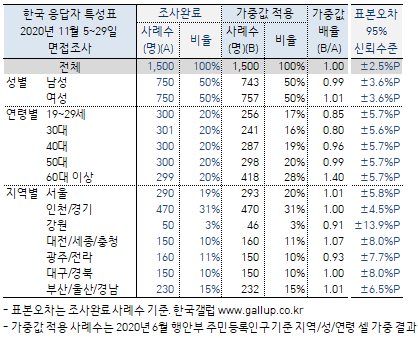
| 전 대륙에서 시장조사와 여론조사를 하는 글로벌 네트워크 WIN(Worldwide Independent Network of Market Research)은 매년 말 건강, 환경, IT 등 여러 분야 현안에 관해 다국가 비교 조사를 하고 있습니다. 지난 연말부터 〈코로나19와 백신〉 〈성평등 인식〉에 이어 오늘은 〈건강 상태 인식과 관련 행동〉 조사 결과를 전합니다. 2018년, 2019년 코로나19 팬데믹 이전과 비교 가능합니다. |
건강 상태 인식과 관련 행동 - WIN 다국가 조사
→ 한국+세계 조사 결과 파일 다운로드(PDF)
/ 세계 조사 개요
2020년 10~12월 34개국 성인 총 29,252명 전화/온라인/면접조사(주제별 참여국 상이)
/ 한국 조사 개요
- 조사기간: 2020년 11월 5~29일
- 표본추출: 2단계 층화 집락 무작위 추출
- 응답방식: 면접조사원 인터뷰
- 조사대상: 전국(제주 제외) 만 19세 이상 1,500명
- 표본오차: ±2.5%포인트(95% 신뢰수준)
- 응답률: 26%(총 접촉 5,856명 중 1,500명 응답 완료)
- 의뢰처: 한국갤럽-WIN 자체 조사
/ 조사 항목
- 본인의 전반적인 건강 상태 인식(4점 척도)
- 건강 관련 행동 빈도(5점 척도): 흡연, 음주, 스트레스, 운동, 숙면
(※ 세계 조사 상세 결과는 첨부 파일 참조)
요약
- 2020년 10~12월 34개국 성인 중 79%, 스스로 건강하다고 인식
- 코로나19 이전과 크게 달라지지 않아
- '항상+자주 한다': 숙면 64%, 운동 39%, 스트레스 경험 31%, 흡연 17%, 음주 15%
- 한국인은 음주 잦고 운동 덜하는 편, 2019년 대비 2020년 숙면자 감소
- 코로나19 이전 대비 스트레스·운동 빈도, 한국 남녀 변화 경향 달라
조사 결과
2020년 10~12월 34개국 성인 중 79%, 스스로 건강하다고 인식
- 코로나19 이전과 크게 달라지지 않아
글로벌 조사 네트워크 WIN이 2020년 10~12월 34개국 성인 29,252명에게 본인의 전반적인 건강 상태가 어떠하다고 생각하는지 물었다(4점 척도). 그 결과 20%가 '매우 건강하다', 59%는 '건강한 편'이라고 답했다. 즉, 34개국 성인 열 명 중 여덟 명(79%)이 전반적으로 건강하다고 생각한다. 17%는 '건강하지 않은 편', 3%는 '전혀 건강하지 않다'고 답했고 1%는 의견을 유보했다.
◎ 지난 2018년과 2019년에도 조사에 참여한 약 40개국 성인 중 76%, 77%가 스스로 건강하다고 답한 바 있다. 코로나19 팬데믹으로 많은 사람이 목숨을 잃거나 감염 후유증을 앓게 되었고, 일부 국가는 여전히 기약 없는 백신 접종을 기다리는 상태지만 자신의 건강 상태에 대한 인식은 이전과 크게 달라지지 않았다. 이는 개개인이 건강을 신체적 상태 외 다른 측면까지 포함해 생각하기 시작했음을 보여준다. 코로나19라는 실체적 위협에 직면한 상황에서 감염을 피했거나 살아남은 것만으로도 건강하다고 생각할 수 있으며, 방역을 위해 일상 위생에 신경 쓰는 등 스스로를 더 잘 돌보게 된 결과일 수도 있다.


한국, '나는 전반적으로 건강하다' 90%로 34개국 중 최상위권
- '매우 건강하다' 1994년·2002년 40% 안팎 → 2018년 이후 10%대
- 코로나19 전후 비교하면 20·30대 남성, 20~40대 여성 '매우 건강하다' 응답 감소 두드러져
한국 조사는2020년 11월 5~29일 전국(제주 제외) 성인 1,500명을 대상으로 했다. '전반적으로 매우 건강하다'가 16%, '건강한 편' 75%, '건강하지 않은 편' 9%, '전혀 건강하지 않다' 1%다. '매우 건강하거나 건강한 편' 응답은 90%로, 34개국 중에서도 최상위권에 속한다. 1994년, 2002년 같은 질문을 했을 때 '매우 건강하거나 건강한 편' 응답은 각각 75%, 82%였다.
'매우 건강하다'는 응답만 보면 1994년(36%)과 2002년(43%) 40% 안팎에서 2018년 이후 10%대로 크게 감소했다. 코로나19 전후인 2019년과 2020년을 비교하면 20·30대 남성과 20~40대 여성에서만 '매우 건강하다'는 응답이 10%포인트 가까이 감소했고, 그 외 성·연령대에서는 거의 변함없다는 점에 주목할 만하다.
◎ '매우 건강하다'는 응답은 고연령일수록 적고(20대 30%; 60대+ 7%), 한국뿐 아니라 다른 나라에서도 마찬가지 경향을 보인다. 우리나라는 21세기 들어 급격한 고령화가 진행되고 있으므로, 전반적인 건강 상태 인식 저하는 불가피한 현상일 수도 있다. 그러나, 과거와 비교하면 고령층뿐 아니라 젊은 층에서도 '매우 건강하다'는 응답이 현저히 줄었다. 2002년 조사에서는 당시 20대의 54%, 30·40대는 약 45%, 50대 이상에서도 30%가 '매우 건강하다'고 답했다.

___
2020년 34개국 성인의 건강 관련 행동 '항상+자주 한다':
숙면 64%, 운동 39%, 스트레스 경험 31%, 흡연 17%, 음주 15%
- 한국: 음주 잦고 운동은 덜하는 편, 2019년 대비 숙면자 감소
다음으로, 건강에 좋은 행동 두 가지(숙면/잘 잠, 운동)와 건강에 좋지 않은 행동 세 가지(흡연, 음주, 스트레스) 각각에 대한 빈도를 물었다. 그 결과 34개국 성인 중 64%가 '평소 잠을 잘 잔다'(이하 5점 척도 중 '(항상+자주) 한다' 응답 기준), 39%는 규칙적으로 운동한다고 답했다. 31%는 일상에서 스트레스에 시달리고, 흡연과 음주가 잦은 사람은 각각 17%, 15%로 파악됐다.
◎ 한국인 중에서는 59%가 잠을 잘 자는 편이고, 28%가 규칙적으로 운동한다. 스트레스가 잦은 사람은 27%, 음주와 흡연이 잦은 사람은 각각 25%, 19%로 나타났다. 한국의 음주자 비율은 34개국 평균을 웃돌고, 규칙적으로 운동하는 사람은 다른 나라보다 적은 편이라고 볼 수 있다. 34개국 중에서 한국보다 더 자주 술 마시는 나라는 일본(45%), 아일랜드(31%), 영국(30%), 덴마크(27%) 등이며, 캐나다(25%)와 미국·핀란드(23%)는 한국과 비슷한 수준이다.
◎ 코로나19 팬데믹 이전인 2019년과 비교하면, 2020년 한국인 중 흡연·음주·스트레스 경험·운동을 자주 하는 사람은 각각 1~3%포인트 늘었다. 단, 평소 숙면을 취하는 사람은 2019년 68%에서 2020년 59%로 감소한 점이 두드러진다.
응답자 특성별로 볼 때 흡연자와 음주자는 성·연령별 치우침 없이 고르게 늘었고, 숙면자 역시 고르게 줄었다. 그러나, 스트레스에 시달리는 사람은 남성(2019년 32% → 2020년 29%)에선 소폭 줄고 여성(20%→25%)에선 늘었다. 규칙적으로 운동하는 사람 역시 남성(24%→30%)에서는 증가, 여성(27%→25%)에서는 소폭 감소해 성별 차이를 보였다.
◎ 코로나19 이후 여행과 이동, 외식과 모임 등에 제약이 많아졌다. 직장인은 재택근무, 학생은 온라인수업 등으로 집안에 머무는 시간이 길어졌고, 무수한 볼거리를 제공하는 영상 서비스 이용이 늘었다. 일부 업종 종사자는 소득이 줄어 어려움을 겪고 있다. 이러한 일상의 변화는 한국인이 예전보다 흡연·음주를 더 자주 하고, 편히 잠들지 못하는 것과 무관치 않아 보인다.
참고로, 만 13세 이상 한국인의 최근 한 달 OTT 유료 서비스 이용률은 2020년 초 10%에서 2021년 초 23%로 늘었다. 유튜브(무료 포함) 최근 한 달 이용률은 80%를 웃돈다(60대 이상 2020년 40% → 2021년 57%). 2021년 3월 한국갤럽의 만 25~54세 직장인 조사에 따르면 코로나19 이후 회식 빈도 감소 76%, 소득 감소 48%, 회사 경영 상황 악화 52%, 업무 스트레스 증가 52%, 가족과 함께하는 시간 증가 48% 등으로 나타난 바 있다(→ G20210329).

__
국가별 & 한국 교차 집계표










──────────────────────
Health Perception and Lifestyle in Global Pandemic Times
──────────────────────
WIN International, the world's leading association in market research and polling, has published the Annual WIN World Survey (WWS - 2020) exploring the views and beliefs of 29,252 individuals among citizens from 34 countries across the globe about their health and lifestyle. The survey analyzes views and opinions related to the perception of health and habits of citizens.
HEADLINES
The year 2020 was full of unexpected changes, marked mainly by COVID-19 pandemic. Global economic and health crisis, alongside the adjustment of people to new lifestyles, were central last year.
In this context, WIN analyzed individuals’ health perception. While health per se used to be considered primarily as a biological and physical condition, nowadays other variables are considered as much important, such as the context we live in, our culture, our values, as well as the mental, cognitive and psychological conditions.
Despite all the negative consequences caused by the pandemic during the year 2020, 79% of the global population perceived themselves as healthy1. The consistent result with previous measurements reveals that individuals worldwide might have started thinking about health as a set of different aspects besides the physical state. Of course, COVID19 is a very real and tangible threat, but for this very reason, people might consider themselves healthy even just because they could survive or avoid COVID19. In addition, precisely because of the threat caused by the pandemic, people might have started taking better care of themselves with simple, everyday actions.
However, despite the large majority considers themselves healthy, 20% of the population still consider themselves not healthy2. Results shows that males tend to perceive themselves healthier than females. On the other hand, the survey reveals that the highest the education level of individuals, the healthiest they perceive themselves: some could argue that maintaining certain levels of activity by having an employment, studying and/or being a housewife seems to impact positively on the health perception compared to people being unemployed or retired.
While keeping in mind the broader meaning of health, citizens in Africa consider themselves among the healthiest continent (90%)1. On the global picture, Africa was far less hit by the pandemic in 2020 compared to other continents like Europe and Americas. On the other hand, MENA is the region with the lowest rate of health perception observed (72%). When looking at countries, citizens in Indonesia (92%), South Korea (91%) and Pakistan (91%) consider themselves healthier than citizens in Hong Kong (66%), Finland (65%) and Chile (61%), which are on the bottom of the ranking.
As previously mentioned, health perception involves a complex mixture of variables, including everyday habits. In the present study, we focused on five specific habits which were both categorized as good and bad habits, and as action based and non-action based- habits. The difference is that the latter relies on variables not always subjected by people´s choice. The positive habits explored in the study were “sleep well” (a non-action based habit) and “exercise” (an action-based habit).
Sleep well
Sleeping well is necessary for the good maintenance of both the body and the cognitive functioning, as well as emotional regulation. During 2020, 64%3 of the global population admits to sleep well, an even better rate compared to last year´s (+3).
Males tend to sleep well more frequently than females, whereas people aged 35 to 45, probably because they’re more involved in their work lives than other age groups, tend to sleep well less often. Additionally, the highest the social class of belonging, the better they sleep; a similar tendency was observed in the relation between academic achievement and quality of sleep.
While retired people, full time workers and self-employed seems to have the better quality of sleep, housewives are the ones who sleep the worst, especially considering this specific context brought by the pandemic. Having children at home for months and being more often in charge of their activities (eating, studying, sleeping...) might have increased the stress within this category, unleashing a worst sleep quality.
APAC and Europe are the regions with the better sleep quality among their citizens (69%3 and 64%3, respectively), while the opposite occurs in MENA region (54%). Palestinian Territories (51%), Mexico (49%) and Chile (48%) are at the bottom of the ranking.
Exercise
According to the results, 39%3 of people worldwide exercised regularly during 2020, +2% than the two previous years. Nonetheless, there is still a high rate of people doing little or no exercises at all (31%). Despite the safety measures put in place, which prevented people from going to the gym or to field courts, people who already exercised before adapted to the new conditions and kept doing exercises. Probably, many others, considering the difficulties of walking and moving around, started exercising at home precisely due to the safety measures adopted.
Females exercise less than males and, once again, housewives are the ones who exercise the less among other employment categories. A positive outcome is that it’s not only the youngest (from 18 to 34) who exercise the most, but also people aged 65 or more, another possible consequence of COVID19 which is a higher threat for seniors.
In Africa, Europe and APAC 4 out of 10 people practice exercises regularly. Citizens in Finland (58%) and Spain (57%) are more likely to exercise than citizens in Peru (26%), Mexico (23%) and Chile (20%).
Suffer from stress
Suffer from stress is the first bad and non-action-based habit considered. During 2020, 31%3 of population suffered from stress regularly, while only 35% didn´t. Once again, despite the difficult context experienced, the variation between the results from 2020 and previous years is minimum.
Younger females (from 18 to 24), people with low incomes, students, unemployed, housewives and part-time workers are among the individuals who tend to suffer from stress the most. Unsurprisingly, these individuals also represent the most vulnerable population around the globe, a result that emphasizes the relation between social vulnerability and stress.
While MENA is the region with the highest rates of stress within the population (37%), the region with lesser stress rate is APAC (28%). In terms of countries, top countries with more stressed individuals are Japan (49%) and Serbia (49%). Bottom countries are Vietnam (11%) and Denmark (13%).
Smoking and drinking
Nowadays, both smoking and drinking are uncommon habits, which were classified in the study as bad, action-based behaviors. Overall, 17%3 of the global population smokes regularly, while 15% drinks alcohol regularly. Even if last year´s rates didn´t change considerably in comparison with previous years, it is highly relevant at this moment to reduce the consumption of cigarettes and alcohol.
It is identified that males smoke and drink considerably more than females (smoking: 22% vs. 11%, and drinking: 20% vs. 11%).
Citizens in MENA region smoke more frequently (34%), while citizens in Africa smoke way less (4%). Palestinian Territories (36%), Lebanon (28%) and Serbia (28%) are the countries with the higher number of smokers. On the other hand, Nigeria (4%), Peru (5%) and Paraguay (5%) are the ones with less smokers.
In Europe (20%) and APAC (16%) we find the most recurrent alcohol drinkers, the opposite of the habits in MENA (4%) region. Japan (45%), Ireland (32%) and Great Britain (30%) have the higher percentages of drinkers, while Palestinian Territories (1%), Indonesia (3%) and Peru (4%) show the lowest rates.
Vilma Scarpino, President of WIN International Association, said:
“Despite the difficulties faced during last year, which largely involved health and economic resources, individuals’ health perception did not change significantly from previous measurements. On one hand, the COVID19 pandemic might have made us more sensible and careful towards our own health, pushing us to keep up with good and healthy habits or to start new ones. On the other hand, being faced with such an enormous threat as coronavirus, might have led us to consider the little aspects in life as more important, and more significant when evaluating our overall health. In previous years, people might have considered themselves healthy when living without severe biological and physical conditions, while this year a healthy individual might also be someone who feels lucky just to have avoided Covid19”.
__
1 Healthy + Very Healthy
2 Somewhat unhealthy + Unhealthy
3 A lot/Very often + Moderately/Fairly often
_____
응답자 특성표
조사 결과는 행정안전부 주민등록인구 기준으로 가중 처리하여 최종 결과를 산출합니다. 아래 응답자 특성표의 조사완료 사례수는 실제 응답 완료한 인원, 가중값 적용 사례수는 2020년 6월 행정안전부 주민등록인구 기준 성/연령/지역별 셀 가중 처리 후 인원입니다.
